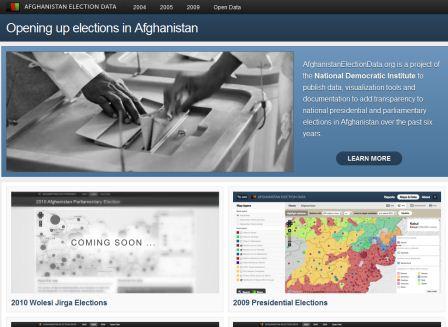Opening Afghanistan's Elections

In the run-up to this weekend's parliamentary (Wolesi Jirga or WJ) vote in Afghanistan, NDI has just launched our latest election data site - AfghanistanElectionData.org. We've added results data from the 2004 Presidential and 2005 Wolesi Jirga to the 2009 data set that we built last year in partnership with Development Seed.
We also greatly improved the maps, including adding Dari base layers, and introduced a new 'Open' section that provides all the election and map data in one place for easy download.
The data and visualization tools we've developed can be a huge asset to NDI staff in Kabul, Afghan civic groups, political parties, media, and international organizations working on the balloting. Using past election data enables groups to plan and target their monitoring, support and other activities - for the upcoming election and beyond.
Of course we're going to post the results from Saturday's election as well. Unfortunately the IEC (Independent Election Commission) doesn't plan to announce results until the end of October, so don't refresh the site all night post-election expecting to see the breaking returns. We're hoping the cooperative meetings we've had with the IEC will result in receiving the data sets in an easier-to-use format than the 2009 election.
Scraping numbers from a 2,500 page PDF is not a lot of fun.
Whatever it takes, we're committed to getting the 2010 results up there ASAP after they are announced.
Once we've got the 2010 results, more important political activities can happen: we can use the tool to evaluate what took place on Saturday, and compare 2010 Wolesi Jirga data to past elections. Particularly important will be comparing these results to the 2005 WJ elections and the more recent 2009 presidentials.
With that raw data in our hands we'll build more data visualization tools, similar to those on the 2009 site, to try and illuminate key electoral factors that surfaced from the election.
In 2009, for example, fraud was a major concern and the tools we designed allowed analysis of the election using the fraud indicators that were established by the Electoral Complaints Commission that formed after the election.
Fraud will likely be a concern again this weekend; it is also clear that voter disenfranchisement due to polling stations being shut down and turnout concerns due to threats from the Taliban will also be high-impact factors.
Until we get our hands on the information we won't know all the tools needed to illuminate the election results. That's the beauty of open data, though: based on the political factors and the information available, NDI, our partners, and other technically-minded activists from around the world will build tools that help shed some light on the situation.
The world will then be able to use these tools to see if the will of the Afghan voters are adequately reflected in the election result.
Post updated to include additional information on development partner DevSeed - 9/16.
